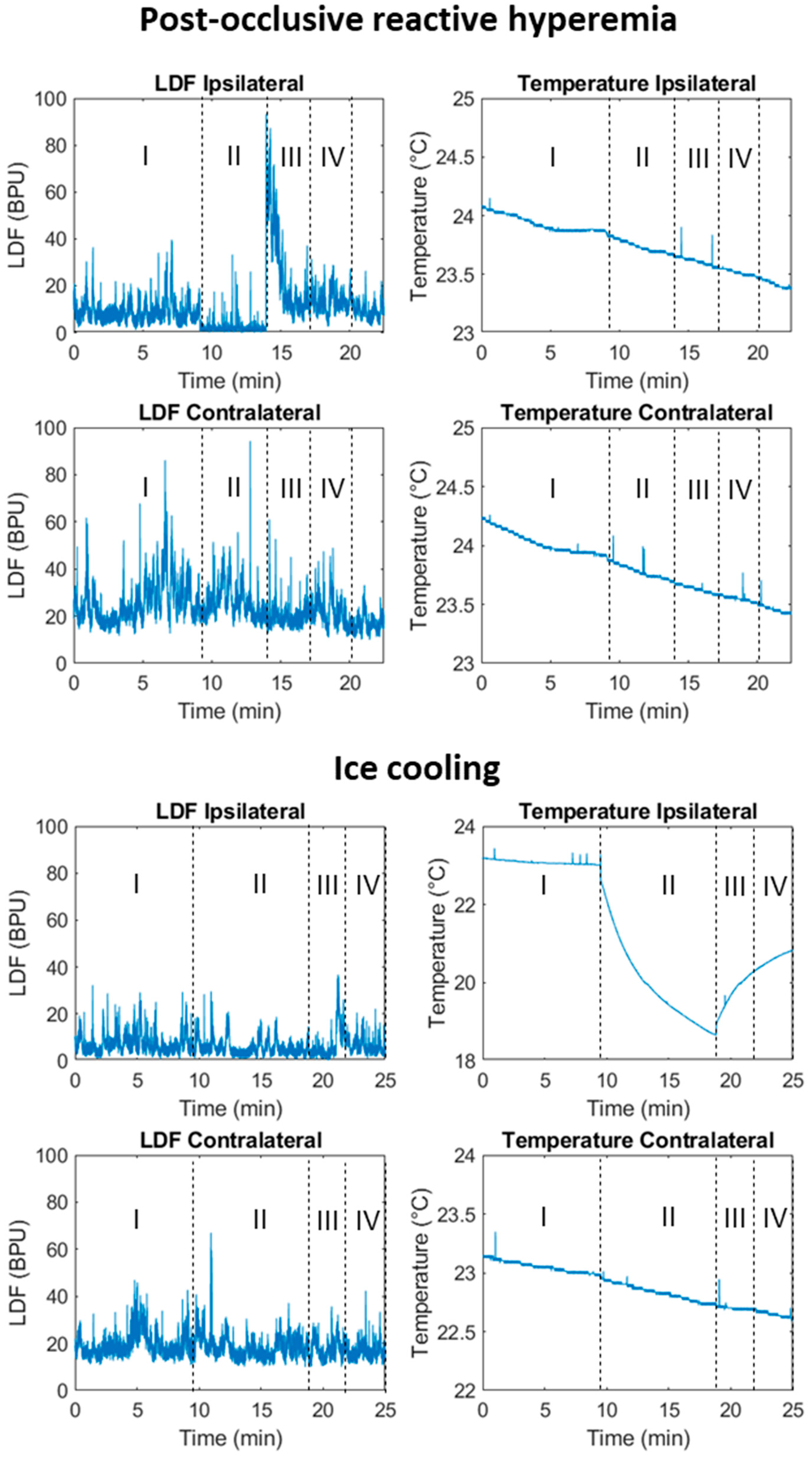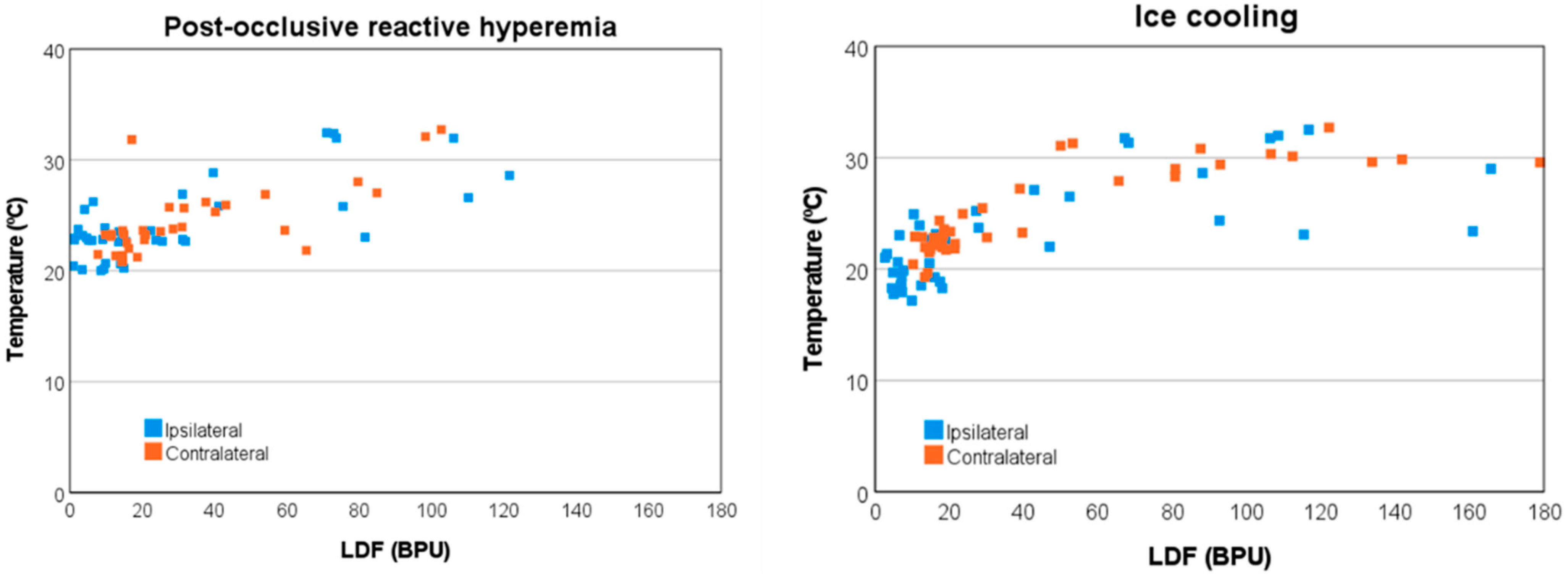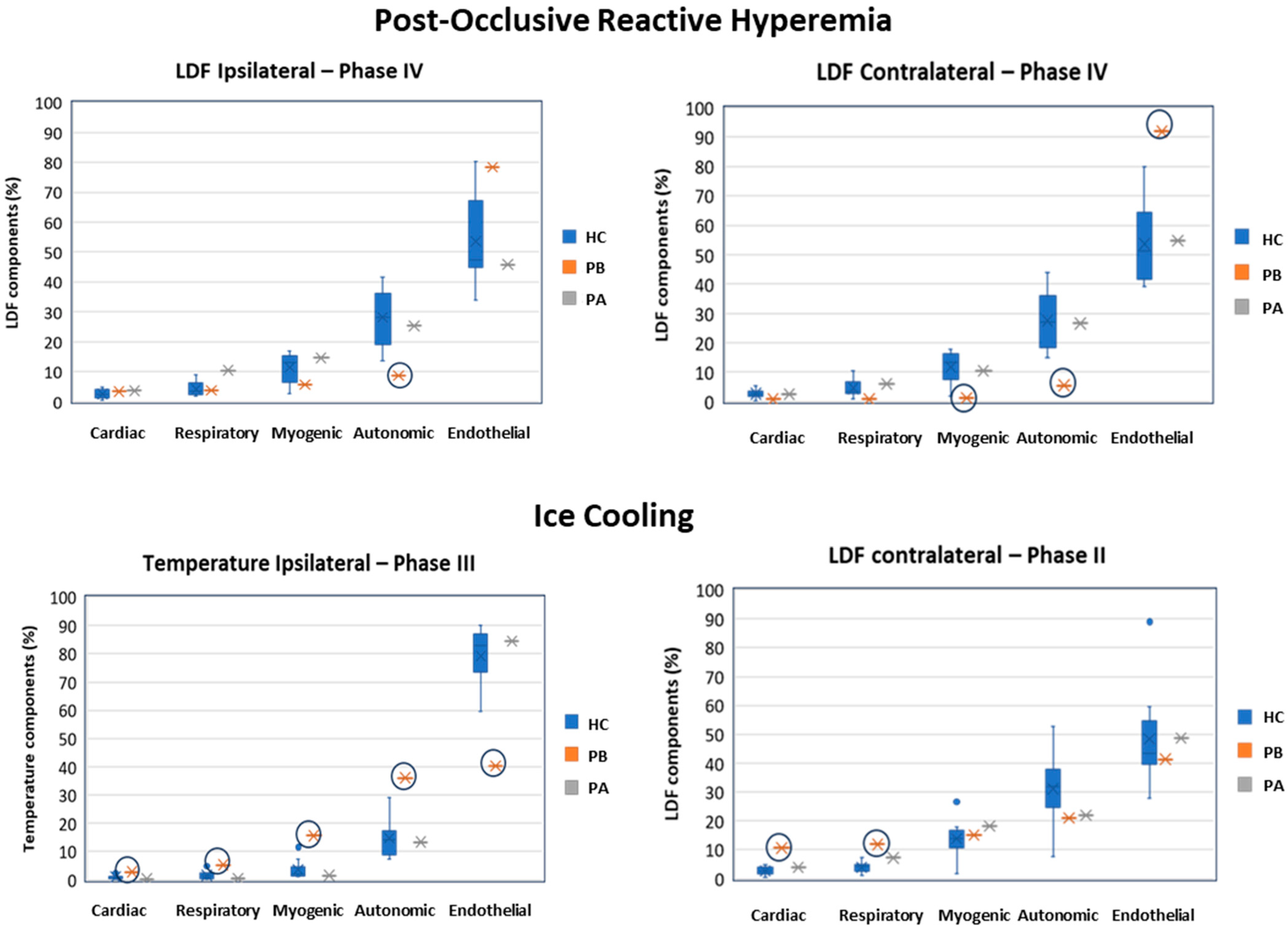Studying Erythromelalgia Using Doppler Flowmetry Perfusion Signals and Wavelet Analysis—An Exploratory Study
Abstract
1. Introduction
2. Methods
2.1. The Patient
2.2. The Control Group
2.3. Experimental
2.4. Post-Occlusive Reactive Hyperemia (PORH)
2.5. Cooling
2.6. Measurement and Data Analysis
3. Results
4. Discussion
5. Conclusions
Author Contributions
Funding
Institutional Review Board Statement
Informed Consent Statement
Data Availability Statement
Acknowledgments
Conflicts of Interest
References
- Mann, N.; King, T.; Murphy, R. Review of primary and secondary erythromelalgia. Clin. Exp. Dermatol. 2019, 44, 477–482. [Google Scholar] [CrossRef] [PubMed]
- Tham, S.W.; Giles, M. Current pain management strategies for patients with erythromelalgia: A critical review. J. Pain Res. 2018, 11, 1689–1698. [Google Scholar] [CrossRef] [PubMed]
- Davis, M.D.; O’Fallon, W.M.; Rogers, R.S., 3rd; Rooke, T.W. Natural history of erythromelalgia: Presentation and outcome in 168 patients. Arch. Dermatol. 2000, 136, 330–336. [Google Scholar] [CrossRef] [PubMed]
- Chan, M.K.H. Erythromelalgia: An endothelial disorder responsive to sodium nitroprusside. Arch. Dis. Child. 2002, 87, 229–230. [Google Scholar] [CrossRef] [PubMed]
- Parker, L.K.; Ponte, C.; Howell, K.J.; Ong, V.H.; Denton, C.P.; Schreiber, B.E. Clinical features and management of erythromelalgia: Long term follow-up of 46 cases. Clin. Exp. Rheumatol. 2017, 35, 80–84. [Google Scholar] [PubMed]
- Feng, S.; He, Z.; Que, L.; Luo, X.; Liang, L.; Li, D.; Qin, L. Primary erythromelalgia mainly manifested by hypertensive crisis: A case report and literature review. Front. Pediatr. 2022, 10, 796149. [Google Scholar] [CrossRef]
- Michelerio, A.; Tomasini, C.; Arbustini, E.; Vassallo, C. Clinical Challenges in Primary Erythromelalgia: A Real-Life Experience from a Single Center and a Diagnostic-Therapeutic Flow-Chart Proposal. Dermatol. Pract. Concept. 2023, 13, e2023191. [Google Scholar] [CrossRef]
- Drenth, J.P.H.; Vuzevski, V.; van Joost, T.; Casteelsvandaele, M.; Vermylen, J.; Michiells, J.J. Cutaneous pathology in primary erythromelalgia. Am. J. Derm. 1996, 18, 30–34. [Google Scholar] [CrossRef][Green Version]
- Davis, M.D.; Weenig, R.H.; Genebriera, J.; Wendelschafer-Crabb, G.; Kennedy, W.R.; Sandroni, P. Histopathologic findings in primary erythromelalgia are nonspecific: Special studies show a decrease in small nerve fiber density. J. Am. Acad. Dermatol. 2006, 55, 519–522. [Google Scholar] [CrossRef]
- Davis, M.D.; Sandroni, P.; Rooke, T.W.; Low, P.A. Erythromelalgia: Vasculopathy, neuropathy, or both? A prospective study of vascular and neurophysiologic studies in erythromelalgia. Arch. Dermatol. 2003, 139, 1337–1343. [Google Scholar] [CrossRef]
- Mork, C.; Asker, C.L.; Salerud, E.G.; Kvernebo, K. Microvascular arteriovenous shunting is a probable pathogenetic mechanism in erythromelalgia. J. Investig. Dermatol. 2000, 114, 643–646. [Google Scholar] [CrossRef] [PubMed][Green Version]
- Mørk, C.; Kvernebo, K.; Asker, C.L.; Salerud, E.G. Reduced skin capillary density during attacks of erythromelalgia implies arteriovenous shunting as pathogenetic mechanism. J. Investig. Dermatol. 2002, 119, 949–953. [Google Scholar] [CrossRef][Green Version]
- Mork, C.; Kalgaard, O.M.; Kvernebo, K. Impaired Neurogenic Control of Skin Perfusion in Erythromelalgia. J. Investig. Dermatol. 2002, 118, 699–703. [Google Scholar] [CrossRef] [PubMed][Green Version]
- Kalgaard, O.M.; Clausen, O.P.; Mellbye, O.J.; Hovig, T.; Kvernebo, K. Nonspecific capillary proliferation and vasculopathy indicate skin hypoxia in erythromelalgia. Arch. Dermatol. 2011, 147, 309–314. [Google Scholar] [CrossRef] [PubMed]
- Leroux, M.B. Erythromelalgia: A cutaneous manifestation of neuropathy? An. Bras. Dermatol. 2018, 93, 86–94. [Google Scholar] [CrossRef] [PubMed]
- Silva, H.; Ferreira, H.; Bujan, M.J.; Rodrigues, L.M. Regarding the quantification of peripheral microcirculation-comparing responses evoked in the in vivo human lower limb by postural changes, suprasystolic occlusion and oxygen breathing. Microvasc. Res. 2015, 99, 110–117. [Google Scholar] [CrossRef] [PubMed]
- Silva, H.; Ferreira, H.; Renault, M.A.; Silva, H.P.; Rodrigues, L.M. The venoarteriolar reflex significantly reduces contralateral perfusion as part of the lower limb circulatory homeostasis in vivo. Front. Physiol. 2018, 9, 1123. [Google Scholar] [CrossRef]
- Florindo, M.; Nuno, S.; Andrade, S.; Rocha, C.; Rodrigues, L.M. The Acute Modification of the Upper-Limb Perfusion In Vivo Evokes a Prompt Adaptive Hemodynamic Response to Reestablish Cardiovascular Homeostasis. In Physiology21 Annual Conference Abstract Book 2021. 2021. Available online: https://static.physoc.org/app/uploads/2021/06/10115155/Physiology-2021-Abstract-Book.pdf (accessed on 15 November 2023).
- Faloni de Andrade, S.; Granja, T.; Monteiro Rodrigues, L. Comparative view of reactive hyperemia perfusion changes in the upper-limb by laser Doppler flowmetry and optoacoustic tomography. Biomed. Biopharm. Res. 2023, 20, 3–12. [Google Scholar] [CrossRef]
- Monteiro Rodrigues, L.; Rocha, C.; Andrade, S.; Granja, T.; Gregório, J. The acute adaptation of skin microcirculatory perfusion in vivo does not involve a local response but rather a centrally mediated adaptive reflex. Front. Physiol. 2023, 14, 1177583. [Google Scholar] [CrossRef]
- Rodrigues, L.M.; Rocha, C.; Ferreira, H.; Silva, H. Different lasers reveal different skin microcirculatory flowmotion—Data from the wavelet transform analysis of human hindlimb perfusion. Sci. Rep. 2019, 9, 16951. [Google Scholar] [CrossRef]
- Aboyans, V.; Criqui, M.H.; Abraham, P.; Allison, M.A.; Creager, M.A.; Diehm, C.; Fowkes, F.G.; Hiatt, W.R.; Jönsson, B.; Lacroix, P. Measurement and interpretation of the ankle-brachial index: A scientific statement from the American heart association. Circulation 2013, 126, 2890–2909. [Google Scholar] [CrossRef] [PubMed]
- World Medical Association. World Medical Association Declaration of Helsinki: Ethical principles for medical research involving human subjects. JAMA 2013, 310, 2191–2194. [CrossRef] [PubMed]
- Roustit, M.; Blaise, S.; Millet, C.; Cracowski, J.L. Reproducibility and methodological issues of skin post-occlusive and thermal hyperemia assessed by single-point laser Doppler flowmetry. Microvasc. Res. 2010, 79, 102–108. [Google Scholar] [CrossRef] [PubMed]
- Rosenberry, R.; Nelson, M.D. Reactive hyperemia: A review of methods, mechanisms, and considerations. Am. J. Physiol. Regul. Integr. Comp. Physiol. 2020, 318, R605–R618. [Google Scholar] [CrossRef]
- Alba, B.K.; Castellani, J.W.; Charkoudian, N. Cold-induced cutaneous vasoconstriction in humans: Function, dysfunction and the distinctly counterproductive. Exp. Physiol. 2019, 104, 1202–1214. [Google Scholar] [CrossRef] [PubMed]
- Ash, C.; Dubec, M.; Donne, K.; Bashford, T. Effect of wavelength and beamwidth on penetration in light-tissue interaction using computational methods. Lasers Med. Sci. 2017, 32, 1909–1918. [Google Scholar] [CrossRef] [PubMed]
- Mizeva, I.; Di Maria, C.; Frick, P.; Podtaev, S.; Allen, J. Quantifying the correlation between photoplethysmography and laser Doppler flowmetry microvascular low-frequency oscillations. J. Biomed. Opt. 2015, 20, 037007. [Google Scholar] [CrossRef]
- Rodrigues, L.M.; Silva, H.; Ferreira, H.; Renault, M.A.; Gadeau, A.P. Observations on the perfusion recovery of regenerative angiogenesis in an ischemic limb model under hyperoxia. Physiol. Rep. 2018, 6, e13736. [Google Scholar] [CrossRef]
- Nilsson, G.E.; Zhai, H.; Chan, H.P.; Farahmand, S.; Maibach, H.I. Cutaneous bioengineering instrumentation standardization: The Tissue Viability Imager. Skin. Res. Technol. 2009, 15, 6–13. [Google Scholar] [CrossRef]
- Pedersen, B.L.; Bækgaard, N.; Quistorff, B. A near infrared spectroscopy-based test of calf muscle function in patients with peripheral arterial disease. Int. J. Angiol. 2015, 24, 25–34. [Google Scholar] [CrossRef][Green Version]
- Chui, C.K. Wavelet Analysis and Its Applications: An Introduction to Wavelets; Academic Press: Boston, MA, USA, 1992; p. 278. [Google Scholar]
- Grinsted, A.; Moore, J.C.; Jevrejeva, S.; Jevrejeva, S. Application of the cross wavelet transform and wavelet coherence to geophysical time series. Nonlinear Process. Geophys. 2004, 11, 561566. [Google Scholar] [CrossRef]
- Coccarelli, A.; Nelson, M.D. Modeling Reactive Hyperemia to Better Understand and Assess Microvascular Function: A Review of Techniques. Ann. Biomed. Eng. 2023, 51, 479–492. [Google Scholar] [CrossRef] [PubMed]
- Mugele, H.; Marume, K.; Amin, S.B.; Possnig, C.; Kühn, L.C.; Riehl, L.; Pieper, R.; Schabbehard, E.-L.; Oliver, S.J.; Gagnon, D.; et al. Control of blood pressure in the cold: Differentiation of skin and skeletal muscle vascular resistance. Exper. Physiol. 2023, 108, 38–49. [Google Scholar] [CrossRef] [PubMed]
- Sandroni, P.; Davis, M.D.; Harper, C.M.; Rogers, R.S., 3rd; Harper, C.M., Jr.; O’Fallon, W.M.; Rooke, T.W.; Low, P.A. Neurophysiologic and vascular studies in erythromelalgia: A retrospective analysis. J. Clin. Neuromuscul. Dis. 1999, 1, 57–63. [Google Scholar] [CrossRef] [PubMed]
- Littleford, R.C.; Khan, F.; Belch, J.J. Skin perfusion in patients with erythromelalgia. Eur. J. Clin. Investig. 1999, 29, 588–593. [Google Scholar] [CrossRef] [PubMed]
- Kalgaard, O.M.; Mørk, C.; Kvernebo, K. Prostacyclin reduces symptoms and sympathetic dysfunction in erythromelalgia in a double-blind randomized pilot study. Acta Derm. Venereol. 2003, 83, 442–444. [Google Scholar] [CrossRef] [PubMed]
- Mørk, C.; Salerud, E.G.; Asker, C.L.; Kvernebo, K. The prostaglandin E1 analog misoprostol reduces symptoms and microvascular arteriovenous shunting in erythromelalgia-a double-blind, crossover, placebo-compared study. J. Investig. Dermatol. 2004, 122, 587–593. [Google Scholar] [CrossRef]
- Ishii, T.; Takabe, S.; Yanagawa, Y.; Ohshima, Y.; Kagawa, Y.; Shibata, A.; Oyama, K. Laser Doppler blood flowmeter as a useful instrument for the early detection of lower extremity peripheral arterial disease in hemodialysis patients: An observational study. BMC Nephrol. 2019, 20, 470. [Google Scholar] [CrossRef]
- Cracowski, J.L.; Roustit, M. Human Skin Microcirculation. Compr. Physiol. 2020, 10, 1105–1154. [Google Scholar] [CrossRef]
- Monteiro Rodrigues, L.; Granja, T.F.; de Andrade, S.F. Optoacoustic Imaging Offers New Insights into In Vivo Human Skin Vascular Physiology. Life 2022, 12, 1628. [Google Scholar] [CrossRef]
- Guo, T.; Zhang, T.; Lim, E.; López-Benítez, M.; Ma, F.; Yu, L. A Review of Wavelet Analysis and Its Applications: Challenges and Opportunities. IEEE Access 2022, 10, 58869–58903. [Google Scholar] [CrossRef]




| EM Patient | Healthy Participants | |
|---|---|---|
| N | 1 | 10 |
| Age, years (Q1–Q3) | 35.0 | 27.0 (24.0–30.3) |
| Body Mass, kg (Q1–Q3) | 50.5 | 59.0 (52.8–64.5) |
| Height, m (Q1–Q3) | 1.6 | 1.63 (1.60–1.68) |
| BMI, kg/m2 (Q1–Q3) | 19.5 | 21.7 (21.5–23.4) |
| SYSTP, mmHg (Q1–Q3) | 112.0 | 113.1(105.2–115.1) |
| DIASP, mmHg (Q1–Q3) | 71.0 | 75.0 (70.0–84.5) |
| MAP (Q1–Q3) | 84.7 | 87.5 (85.0–94.9) |
| ABI (Q1–Q3) | 1.0 | 1.1 (1.0–1.1) |
| Post-Occlusive Reactive Hyperemia | Cooling | ||||||
|---|---|---|---|---|---|---|---|
| Healthy Control | Patient | Healthy Control | Patient | ||||
| Phase | LDF (BPU) | Before | After | LDF (BPU) | Before | After | |
| Ipsilateral | I | 27.0; (9.1–49.9) | 19.0 | 9.0 | 27.5; (11.6–110.5) | 19.8 | 9.1 |
| II | 3.4; (1.2–12.8) | 12.8 | 4.5 | 11.1; (6.6–92.6) | 10.2 | 3.8 | |
| III | 18.9; (14.4–77.0) | 8.3 | 36.4 | 17.7; (6.5–56.0) | 17.7 | 7.6 | |
| IV | 13.5; (8.0–40.4) | 10.6 | 8.1 | 14.8; (5.8–49.2) | 18.5 | 7.4 | |
| Contralateral | I | 24.8; (14.5–64.4) | 12.6 | 14.5 | 34.9; (18.3–108.0) | 18.3 | 7.0 |
| II | 19.0; (12.0–31.4) | 4.6 | 14.1 | 20.0; (15.1–82.5) | 10.9 | 7.4 | |
| III | 20.4; (14.6–56.8) | 12.3 | 13.4 | 19.7; (14.5–60.1) | 10.2 | 8.8 | |
| IV | 16.2; (15.2–35.3) | 12.0 | 8.9 | 17.8; (12.7–53.8) | 11.7 | 8.9 | |
| Phase | Temp. (°C) | Before | After | Temp. (°C) | Before | After | |
| Ipsilateral | I | 23.2; (22.0–26.7) | 24.6 | 21.9 | 24.4; (22.9–29.7) | 24.7 | 21.8 |
| II | 23.1; (22.1–25.7) | 24.4 | 21.7 | 19.5; (18.3–24.7) | 20.0 | 15.5 | |
| III | 22.9; (22.1–26.5) | 24.2 | 21.7 | 20.4; (18.3–23.9) | 20.6 | 17.7 | |
| IV | 22.8; (22.7–27.3) | 24.1 | 21.7 | 21.0; (19.2–25.0) | 21.8 | 19.0 | |
| Contralateral | I | 23.6; (21.3–26.2) | 25.0 | 21.5 | 23.8; (23.0–30.2) | 24.0 | 21.4 |
| II | 23.4; (21.4–25.7) | 24.7 | 21.4 | 23.2; (22.1–29.2) | 23.8 | 21.1 | |
| III | 23.2; (21.7–26.4) | 25.3 | 21.3 | 22.8; (21.7–28.6) | 23.6 | 20.8 | |
| IV | 23.2; (22.3–25.8) | 25.2 | 21.3 | 22.8; (21.6–28.2) | 23.6 | 20.7 | |
Disclaimer/Publisher’s Note: The statements, opinions and data contained in all publications are solely those of the individual author(s) and contributor(s) and not of MDPI and/or the editor(s). MDPI and/or the editor(s) disclaim responsibility for any injury to people or property resulting from any ideas, methods, instructions or products referred to in the content. |
© 2023 by the authors. Licensee MDPI, Basel, Switzerland. This article is an open access article distributed under the terms and conditions of the Creative Commons Attribution (CC BY) license (https://creativecommons.org/licenses/by/4.0/).
Share and Cite
Rodrigues, L.M.; Caetano, J.; Andrade, S.F.; Rocha, C.; Alves, J.D.; Ferreira, H.A. Studying Erythromelalgia Using Doppler Flowmetry Perfusion Signals and Wavelet Analysis—An Exploratory Study. Biomedicines 2023, 11, 3327. https://doi.org/10.3390/biomedicines11123327
Rodrigues LM, Caetano J, Andrade SF, Rocha C, Alves JD, Ferreira HA. Studying Erythromelalgia Using Doppler Flowmetry Perfusion Signals and Wavelet Analysis—An Exploratory Study. Biomedicines. 2023; 11(12):3327. https://doi.org/10.3390/biomedicines11123327
Chicago/Turabian StyleRodrigues, Luis Monteiro, Joana Caetano, Sergio Faloni Andrade, Clemente Rocha, José Delgado Alves, and Hugo Alexandre Ferreira. 2023. "Studying Erythromelalgia Using Doppler Flowmetry Perfusion Signals and Wavelet Analysis—An Exploratory Study" Biomedicines 11, no. 12: 3327. https://doi.org/10.3390/biomedicines11123327
APA StyleRodrigues, L. M., Caetano, J., Andrade, S. F., Rocha, C., Alves, J. D., & Ferreira, H. A. (2023). Studying Erythromelalgia Using Doppler Flowmetry Perfusion Signals and Wavelet Analysis—An Exploratory Study. Biomedicines, 11(12), 3327. https://doi.org/10.3390/biomedicines11123327









